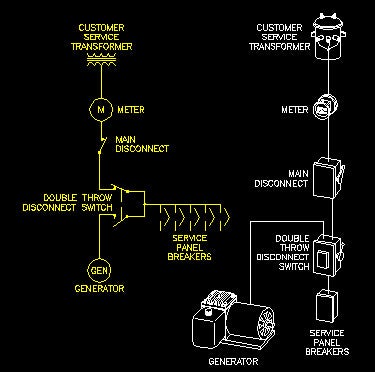
During power outages, many members rely on standby generators to continue supplying electricity. It is reassuring to know that this is an option; however, for the safety of equipment and line crews, generators must be installed with a “double throw disconnect switch.” This totally isolates the standby system from the La Plata Electric Association, Inc. (LPEA) system. Opening the breakers is not adequate.
Article 702 of the National Electric Code (NEC) states that “Optional standby systems are intended to protect private business or property where life safety does not depend on the performance of the system. Optional standby systems are intended to supply on-site generated power to selected loads either automatically or manually.” LPEA considers all on-site generators connected to premise wiring to be “optional standby systems” whether permanently connected or not.
As stated above, a double throw disconnect switch MUST be installed. This switch will totally isolate the standby system from the LPEA system (opening breakers is not adequate). According to the NEC, “Transfer equipment shall be suitable for the intended use and so designed and installed as to prevent the inadvertent interconnection of normal and alternate sources of supply in any operation of the transfer equipment.” A qualified licensed electrician should always be used when sizing and installing any electrical equipment.
The reason for the double throw switch is that even a small, 120-volt generator, can feed back into the LPEA system backwards through a transformer. At the transformer, the voltage is stepped up to the primary voltage of the transformer (usually 7,200 volts). This is a very dangerous situation to personnel who may working on the power lines under the assumption that the lines are not energized.
In addition to putting lives at risk, when the outage is repaired and the line crews restore the power throughout the LPEA system, it travels back to your meter. If the generator is not disconnected from the LPEA system with the double throw switch, the two sources will interconnect, causing serious damage and possible destruction of any equipment operating with standby power.
If you have a generator, please complete and submit the LPEA Member Generator Form
Requirements Diagram
This is a drawing of an acceptable connection of a standby generator.

Points to Remember
- Optional standby generators must be installed with a "double throw switch"
- Always have a licensed electrician install electrical equipment
- Opening breakers is not an adequate precaution for optional standby generators connected to premise wiring
If you have any questions call LPEA at (970) 247-5786 or your electrician.
Safety
Severe weather can cause extensive damage to power lines. When an extended power failure results, portable and standby generators can be great emergency resources.
LPEA Safety Specialist Trenton Webber reminds us that generators must be connected safely and used properly. The two biggest hazards are carbon monoxide poisoning and "back-feed."
Prevent carbon monoxide (CO) poisoning. Always place the generator outdoors and make certain it is vented to the open air. Never operate it indoors, in a confined area (such as a garage, shed, or similar area), or near windows and doors, even with fans running.
Generators produce gases, including deadly carbon monoxide (CO), which you can't see or smell. If you feel sick, dizzy or weak while using a generator, get to fresh air immediately. CO can build up and linger for hours after the generator is turned off.
Follow the manufacturer's instructions. Install battery-operated CO alarms or plug-in CO alarms with battery backup in your home. Test CO alarms often and replace batteries as needed.
Carbon dioxide (CO2) from generators can also be a problem if it displaces too much oxygen.
Avoid back-feed. An improperly connected generator can "back-feed" electricity from a home to the power line. The same transformer that reduces power line voltage for home use — 120/240 volts — will increase generator voltage to 7,200 volts or greater, and send it into the path of a lineman working to restore power. This can be fatal.
Consumers who plan to wire a standby generator into their electrical system should coordinate the work through a licensed electrical contractor.
The following tips may help portable and standby generator users protect themselves, their families and LPEA linemen from back-feed and other hazards. Careful operation helps prevent appliance damage as well.
- Plug appliances directly into the portable generator. Note its wattage capacity to avoid a dangerous overload. Using too many appliances increases the risk of an electrical fire and may damage connected home appliance.
- Before you plug in appliances, have the generator running at full speed. Appliances plugged in prior to starting the generator may be damaged as the generator starts and reaches full power.
- Never wire a portable, temporary generator fired by gasoline or diesel fuel to a circuit breaker, fuse, outlet or your home's service entrance panel.
- The most common portable units — like those used at home construction sites — allow you to plug individual items, like power tools and small appliances, directly into the generator. It powers only those items and is not connected to your home's electrical wiring.
- Get help from a qualified electrician to connect a standby generator directly to your electrical system. Special precautions should be taken to make sure the installation is safe and complies with the National Electrical Code. An electrician can help you obtain proper switches and connections for this type of generator.
- If the generator requires direct wiring, install a double-throw switch or auxiliary generator panel. The switch makes it possible to connect to the main power source OR the generator, but will not allow connection to both at the same time.
This switch protects lineworkers from the dangers of unknown "live" wires, and protects the generator and connected appliances from damage that could occur if the generator is operating when the main power source is restored.
If you loan your generator to someone else, they must also have this double-throw switch or generator panel.
Handle fuel safely and refuel the generator carefully. Make sure the engine is cool to prevent a fire, should the tank overflow. Store gasoline, propane, kerosene and other flammable liquids outside of living areas. Use properly labeled non-glass safety containers. Do not store fuel near a fuel-burning appliance, such as a natural gas water heater. To prevent potentially fatal injuries and appliance damage, use generators with great care.
For more information contact LPEA Safety Specialist Trenton Webber, (970) 382-3533 or email twebber@lpea.coop.
